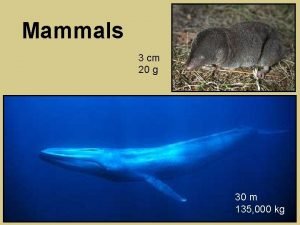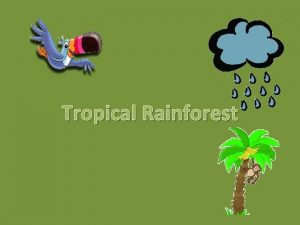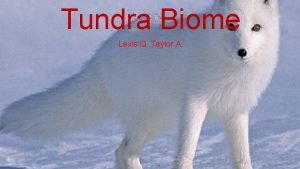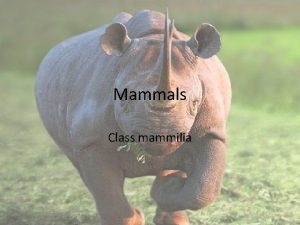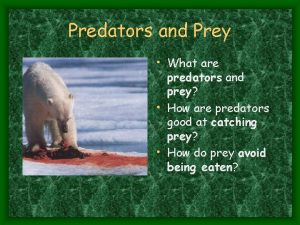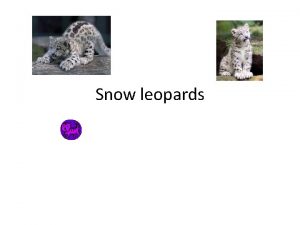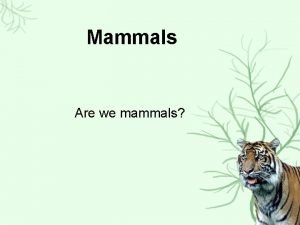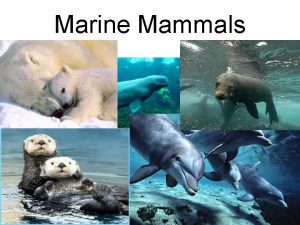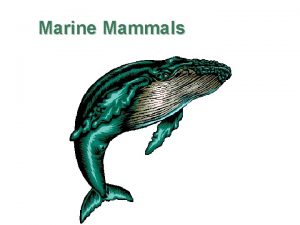Predatory Mammals Role of Predators Secondary consumers totally






















- Slides: 22

Predatory Mammals

Role of Predators • Secondary consumers, totally dependent upon primary consumers • All wild animals belong to this cycle – – Abundant food Population increase Near famine Back to abundance • Cycle affected by food supply, predation, disease and natural disaster

Role of Predators • Keep primary consumer populations stable and in balance by preventing them from increasing so rapidly that food supplies are threatened • Decrease population, thereby allowing food supply to increase • Helps populations of primary consumers stay with in carrying capacity of the land • Do not eliminate, but reduce starvation


Predator Behavior • • • Highly adaptable Forward looking eyes Keen senses Great night vision Opportunists rather than specialist

Wild Cats • • • Elusive predators Quick Nocturnal Lie in wait for long periods of time Highly adaptable to different environments Examples - Canada lynx, Bobcat, Mountain Lion, Jaguar

Canada Lynx • Grayish brown fur • Short tail with black tip • 2 feet at shoulder • Up to 40 pounds • Kittens are spotted at birth

Bobcat • AKA Wildcat • Molted reddish brown fur • Short white tipped tail • Coloration differences depending on habitat

Mountain Lion • • • AKA Puma Large tan colored cat Up to 175 pounds Up to 7. 5 feet in length Rare human attacks and deaths reported • Babies stay with mother for two years

Jaguar • Largest cat in North America • Spotted coat • Prey on domestic livestock • Up to 250 pounds • Up to 30 inches tall

Wild Dogs • Foxes – red, gray, arctic, kit • Diet includes wide variety of rodents, amphibians and smaller predators • Mostly nocturnal • Coyotes – very successful - omnivores • Wolves– prey mostly on ungulates- sheep, cattle deer, hunt in packs – very smart

Fox • • Male- dog Female- vixen Born in dens or burrows Preyed upon by bobcats, wolves, coyotes • Humans trap them for their fur


Coyotes • AKA Prairie wolf/brush wolf • Learned to thrive near human populations • Omnivore • Black tipped bushy tails • Up to 50 pounds • Mate for life

Wolves • Closely related to domesticated dogs • Problem? ? ? • Hunt in packs • One dominant male leader • Only the dominant male and his mate produce offspring

Weasels • Wolverines, minks, badgers, ferrets, martens, fisher, skunk • Can enter dens of many mammals they prey upon • Very efficient predators (sometimes thought to be the most vicious), aggressive • All living things are on the menu

Weasels • Will kill more than they need - even larger animals – Example fishers seldom weigh more than 12 lbs but can take down a deer • Well adapted for survival • Delayed gestation – wait until increased photoperiod (number of daylight hours in day) to ensure spring birth – Better for survival of young



Bears • Largest and most well known predators in North America • Alaskan browns can get huge 4 -5 ft at the shoulder and up to 1500 lbs • Eat just about anything –berries, rodents fish - but will also eat carrion (rotted meat) • Black bear is most widely distributed


• Comparison of very large Alaskan brown bear paw to human
 Third trophic level
Third trophic level Primary producers
Primary producers Labeled energy pyramid
Labeled energy pyramid Pelycosaurs
Pelycosaurs Groups of invertebrates animals
Groups of invertebrates animals Predatory and limit pricing
Predatory and limit pricing Why are big predatory animals rare
Why are big predatory animals rare Tetra pak ii
Tetra pak ii Research outreach predatory
Research outreach predatory How does predatory pricing hurt competition
How does predatory pricing hurt competition Predatory pricing meaning
Predatory pricing meaning Predatory pricing examples
Predatory pricing examples Predatory in a sentence
Predatory in a sentence Chapter 28 role of consumers in a market economy
Chapter 28 role of consumers in a market economy Secondary consumers
Secondary consumers Predator prey relationship in tropical rainforest
Predator prey relationship in tropical rainforest Tundra biome map
Tundra biome map Tropical levels
Tropical levels Energy pyramid for temperate deciduous forest
Energy pyramid for temperate deciduous forest Coral reefs decomposers
Coral reefs decomposers Swamp secondary consumers
Swamp secondary consumers Primary consumer
Primary consumer Bear primary consumer
Bear primary consumer



